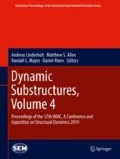Abstract
Spacecraft are subjected to a variety of extreme loads during the course of a mission. One period during which these demanding loads are observed occurs during the parachute deployment stage of reentry. The deployment process utilizes a mortar in order to deploy the parachute and the corresponding reaction forces from deployment generate large impulsive loads on the spacecraft and cause vibrations throughout the spacecraft. Accurate prediction of the forces exerted on the spacecraft during deployment is paramount to the design and safety of the spacecraft. Typically the time history of the reaction forces exerted during parachute deployment are measured experimentally using a tripod-mounted mortar assembly. This approach introduces coupling between the force generated by the mortar and the dynamics of the tripod legs, and does not account for the structural compliance of the actual spacecraft system. This will lead to erroneous results if compared to the true reaction forces observed during the in-service deployment of the parachute during reentry.
In this paper, a cyber-physical test procedure called real-time hybrid substructuring (RTHS) is utilized to test examine the reaction forces which occurred during the parachute deployment of the Mars Pathfinder spacecraft. The RTHS test couples, in real-time, a numerical substructure consisting of a frequency-domain model of the Mars Pathfinder with a physical substructure consisting of a parachute being fired from a mortar in the Shock and Vibration Laboratory at the University of Connecticut. Reaction forces during parachute deployment was tested for both a fixed-base scenario as well as in the case where the dynamics of the spacecraft hull were incorporated into the test. The Mars Pathfinder RTHS test demonstrates a new approach in aerospace testing that can allow for component testing during the design phase to provide more realistic load profiles and dynamic responses of critical components of the spacecraft.
Access this chapter
Tax calculation will be finalised at checkout
Purchases are for personal use only
References
Harris, C.M., Piersol, A.G.: Harris’ Shock and Vibration Handbook, 5th edn. McGraw-Hill, New York (2002)
Ryschkewitsch, M.G.: National Aeronautics and Space Administration. Pyroshock test criteria: NASA-STD-7003A, Washington, DC (2011)
Harris, M.J., Christenson, R.E.: Experimental test of spacecraft parachute deployment using real-time hybrid substructuring. In: Conference Proceedings of the Society for Experimental Mechanics Series, pp. 67–70 (2018)
Blakeborough, A., Williams, M.S., Darby, A.P., Williams, D.M.: The development of real-time substructure testing. Philos. Transact. A Math. Phys. Eng. Sci. 359(1786), 1869–1891 (2001)
Botelho, R.M.: Real-time hybrid substructuring for marine applications of vibration control and structural acoustics. Ph.D. Thesis, Department of Civil, and Environmental Engineering, University of Connecticut (2015)
Nakashima, M., Kato, H., Takaoka, E.: Development of real-time pseudo dynamic testing. Earthquake Eng Struct Dyn. 21, 79–92 (1992)
Mahin, S.A., Shing, P.B.: Pseudodynamic method for seismic testing. J Struct Eng. 111(7), 1482–1503 (1985)
Stehman, N., Nakata, N.: Experimental investigation of inertial force control for substructure shake table tests. In: World Conference on Earthquake Engineering, Lisbon, Portugal (2012)
Author information
Authors and Affiliations
Corresponding author
Editor information
Editors and Affiliations
Rights and permissions
Copyright information
© 2020 Society for Experimental Mechanics, Inc.
About this paper
Cite this paper
Harris, M.J., Christenson, R.E. (2020). Real-Time Hybrid Substructuring Results of the Mars Pathfinder Parachute Deployment. In: Linderholt, A., Allen, M., Mayes, R., Rixen, D. (eds) Dynamic Substructures, Volume 4. Conference Proceedings of the Society for Experimental Mechanics Series. Springer, Cham. https://doi.org/10.1007/978-3-030-12184-6_19
Download citation
DOI: https://doi.org/10.1007/978-3-030-12184-6_19
Published:
Publisher Name: Springer, Cham
Print ISBN: 978-3-030-12183-9
Online ISBN: 978-3-030-12184-6
eBook Packages: EngineeringEngineering (R0)

